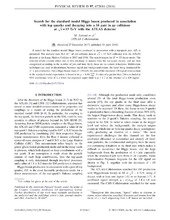Search for the standard model Higgs boson produced in association with top quarks and decaying into a b¯b pair in pp collisions at √s=13 TeV with the ATLAS detector
Aaboud, Morad; Aad, Georges; Abbott, Brad; Abdinov, Ovsat Bahram oglu; Abeloos, Baptiste; Abidi, Syed Haider; AbouZeid, Hass; Abraham, Nadine L.; Abramowicz, Halina; Abreu, Henso; Buanes, Trygve; Dale, Ørjan; Eigen, Gerald; Fomin, Nikolai; Lipniacka, Anna; Martin dit Latour, Bertrand; Mæland, Steffen; Stugu, Bjarne; Yang, Zongchang; Zalieckas, Justas; Bugge, Magnar Kopangen; Cameron, David Gordon; Catmore, James Richard; Feigl, Simon; Franconi, Laura; Garonne, Vincent; Gramstad, Eirik; Morisbak, Vanja; Oppen, Henrik; Ould-Saada, Farid; Read, Alexander Lincoln; Røhne, Ole Myren; Sandaker, Heidi; Serfon, Cédric; Stapnes, Steinar; Vadla, Knut Oddvar Høie; Abulaiti, Yiming; Acharya, Bobby S.; Adachi, Shunsuke; Adamczyk, Leszek; Adelman, Jareed; Adersberger, Michael; Adye, Tim; Affolder, Anthony Allen; Afik, Yoav; Agheorghiesei, Catalin; Aguilar Saavedra, Juan Antonio; Ahlen, Steven; Ahmadov, Faig; Aielli, Giulio; ATLAS, Collaboration
Peer reviewed, Journal article
Published version

Åpne
Permanent lenke
https://hdl.handle.net/1956/19075Utgivelsesdato
2018-04-30Metadata
Vis full innførselSamlinger
Originalversjon
https://doi.org/10.1103/physrevd.97.072016Sammendrag
A search for the standard model Higgs boson produced in association with a top-quark pair, t¯tH, is presented. The analysis uses 36.1 fb−1 of pp collision data at √s=13 TeV collected with the ATLAS detector at the Large Hadron Collider in 2015 and 2016. The search targets the H→b¯b decay mode. The selected events contain either one or two electrons or muons from the top-quark decays, and are then categorized according to the number of jets and how likely these are to contain b-hadrons. Multivariate techniques are used to discriminate between signal and background events, the latter being dominated by t¯t+jets production. For a Higgs boson mass of 125 GeV, the ratio of the measured t¯tH signal cross-section to the standard model expectation is found to be μ=0.84+0.64−0.61. A value of μ greater than 2.0 is excluded at 95% confidence level (C.L.) while the expected upper limit is μ<1.2 in the absence of a t¯tH signal.
